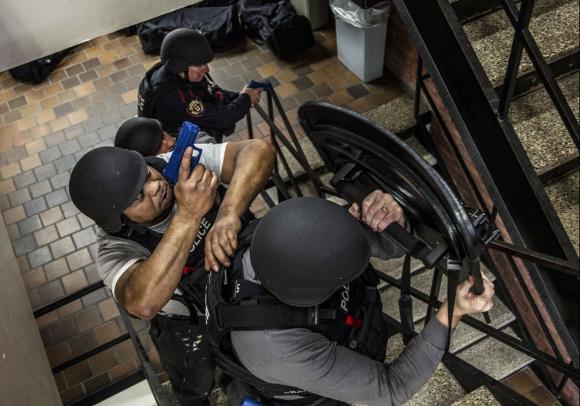PROVIDENCE, R.I. [Brown University] — An active shooter on campus is a scenario Brown hopes never to encounter, but it has happened elsewhere. Colleges around the country are making sure they are prepared just in case.
An integral part of that preparation is police training, so last week, while much of the campus was away on winter break, police officers in the Department of Public Safety at Brown took over Wilson Hall for several days of tactical training sessions.
For many years, DPS police officers have trained with the Providence Police Department on active shooter responses. But last week was the first time that officers trained on campus, in a location where they may one day face an emergency situation.
“In this day and age, training for this type of situation is critical. A prompt response in the difference in saving lives,” said Deputy Chief Paul Shanley.
Last year several officers took part in certification courses in the use of a tactical shield, building clearance, and basic tactical first aid, earning instructor status so that they could run training sessions for DPS officers on campus. The department uses tactical equipment in these drills, including heavy-duty vests and a tactical shield.
A glance into Wilson Hall last week revealed a building buzzing with activity. On the first floor, a group of officers was running building search and tactical entry drills. Wearing bulletproof vests and holding blue and red rubber guns, they practiced moving down the hall and various ways to enter and clear a room.
Above them, on the second floor, another group was using the heavier gear, including the new shield and tactical vests, to practice what to do in the event an intruder with a gun or other weapon was in the building. Each officer took a turn holding the shield and leading the group up stairs and down a hall, giving commands along the way.
Sgt. Elayna Boucher, who was overseeing the training sessions, said that repetition was key.
“It’s important to build muscle memory so that it becomes second nature to the officers. The more drills we do, the better we get at them,” Boucher said.
Later in the day, the officers would head upstairs to the third floor, where Officer Richard Kelly was giving instruction on first-aid survival tactics. Officers would learn how to dress a wound, use a tourniquet on themselves or another person to slow bleeding, and how to assess a wound and relay information to EMTs, who may be waiting until an intruder is caught to enter a building.
DPS hopes to hold more on-campus training sessions so that officers can practice in different buildings and continue to improve their technique.
“Although we hope we don’t have to use this training, we have to always be prepared to respond effectively to a situation like this,” said Shanley. “These situations happen very fast and we have the resources to react very quickly.”

